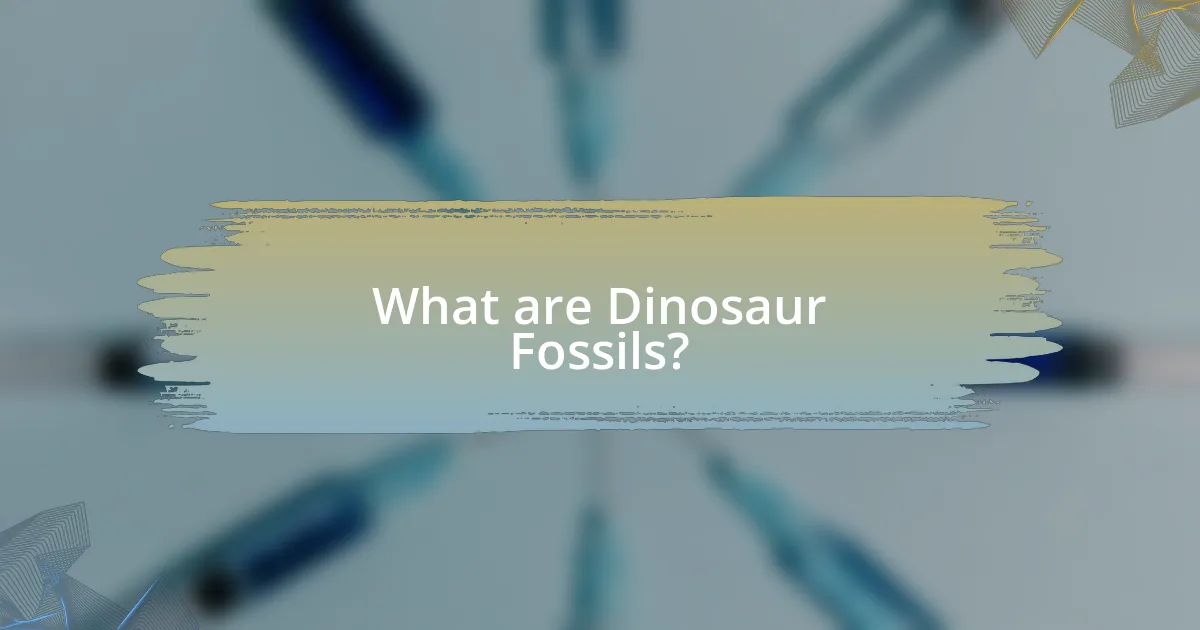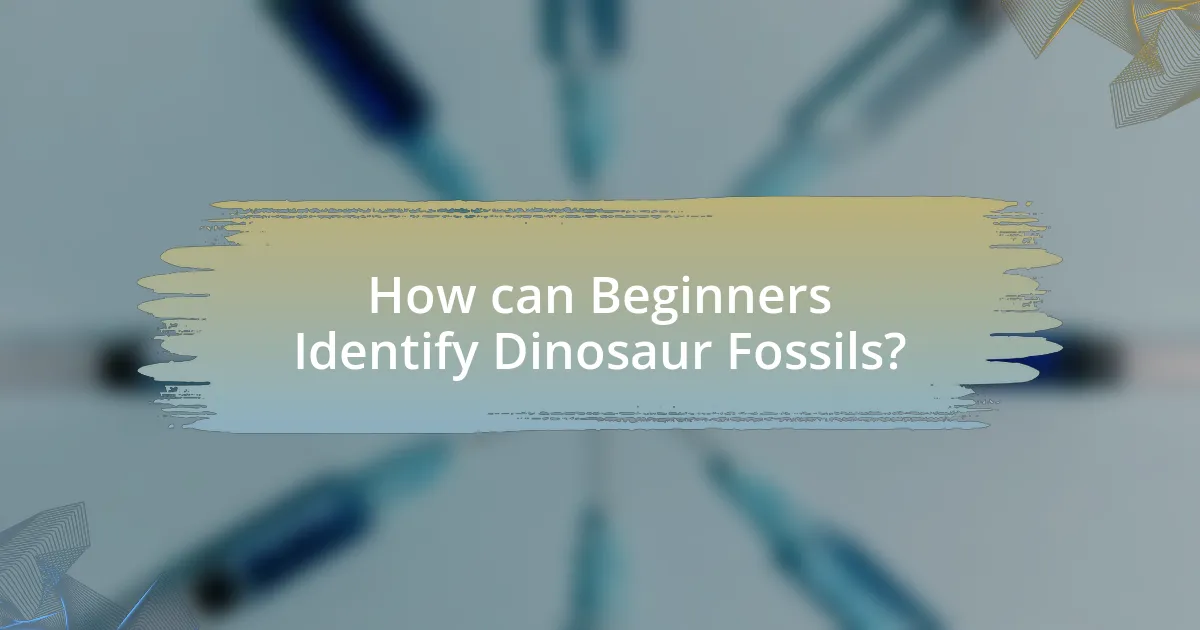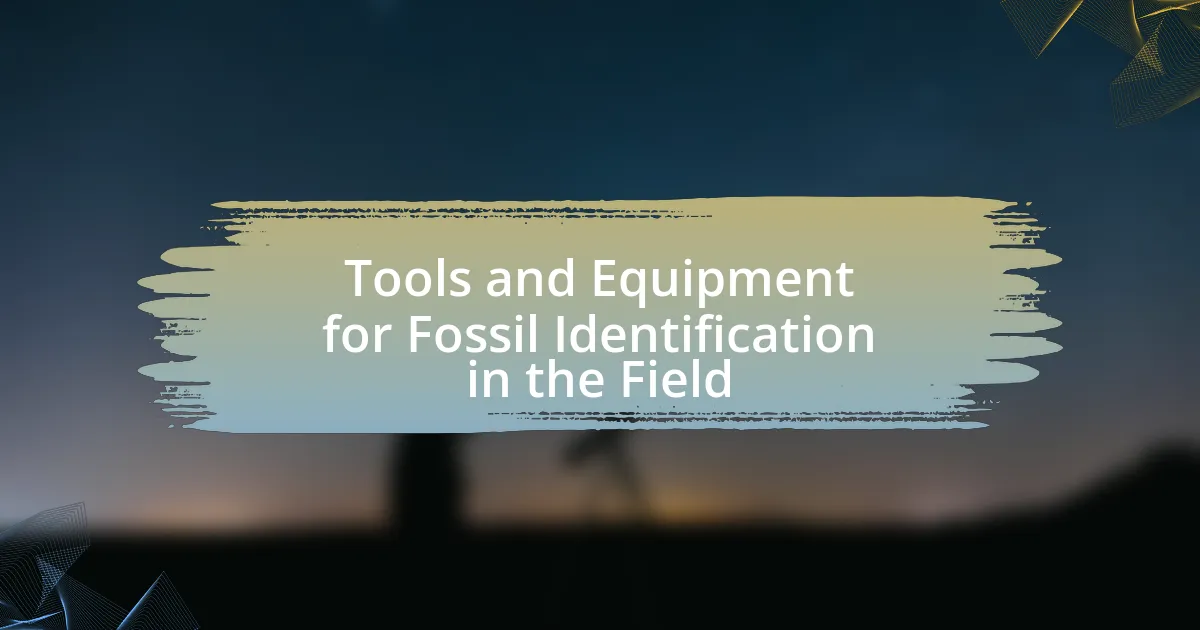The article “A Beginner’s Guide to Identifying Dinosaur Fossils” provides essential information on dinosaur fossils, including their formation, significance, and identification techniques. It explains the fossilization process, the geological conditions conducive to fossil preservation, and the importance of fossils in understanding prehistoric life and evolution. The guide also offers practical advice for beginners on identifying dinosaur fossils, including key characteristics to look for, tools needed, and common mistakes to avoid. Additionally, it highlights notable fossil-rich locations and resources for further learning, making it a comprehensive resource for aspiring fossil hunters.

What are Dinosaur Fossils?
Dinosaur fossils are the preserved remains or traces of dinosaurs that lived millions of years ago. These fossils can include bones, teeth, footprints, and even imprints of skin or feathers, providing crucial evidence about the anatomy, behavior, and environment of these ancient creatures. Fossils are formed through a process called fossilization, where organic materials are replaced by minerals over time, allowing them to endure through geological ages. The study of dinosaur fossils has significantly advanced our understanding of prehistoric life, with notable discoveries such as the nearly complete skeleton of Tyrannosaurus rex, which has provided insights into its size, diet, and habitat.
How are Dinosaur Fossils formed?
Dinosaur fossils are formed through a process called fossilization, which typically involves the burial of dinosaur remains in sediment. When a dinosaur dies, its body may be quickly covered by sediment such as mud or sand, which protects it from decay and scavengers. Over time, layers of sediment accumulate, and the pressure from these layers compresses the remains. Minerals from groundwater seep into the bones, replacing organic material and turning them into rock-like fossils. This process can take thousands to millions of years. Fossilization is supported by geological evidence showing that many dinosaur fossils are found in sedimentary rock layers, indicating the conditions necessary for fossil formation were present during the Mesozoic era.
What geological processes contribute to fossilization?
The geological processes that contribute to fossilization include sedimentation, mineralization, and the conditions of burial. Sedimentation involves the accumulation of sediments that cover organic remains, protecting them from decay. Mineralization occurs when minerals in groundwater replace organic material, turning it into stone. The conditions of burial, such as low oxygen levels and rapid sediment deposition, further enhance preservation by slowing decomposition and preventing scavenging. These processes are essential for the formation of fossils, as evidenced by numerous fossilized remains found in sedimentary rock layers, which demonstrate the effectiveness of these geological mechanisms in preserving ancient life forms.
What types of environments are conducive to fossil formation?
Environments conducive to fossil formation include sedimentary environments such as river deltas, lakes, and ocean floors. These settings provide the necessary conditions for the burial and preservation of organic material, as sediments accumulate and protect remains from decay and scavenging. For instance, the rapid sedimentation in river deltas can quickly cover dead organisms, facilitating fossilization. Additionally, anoxic conditions in deep ocean environments can inhibit decomposition, further enhancing the likelihood of fossil preservation.
Why are Dinosaur Fossils important to science?
Dinosaur fossils are important to science because they provide critical evidence about the history of life on Earth, including the evolution of species and ancient ecosystems. These fossils allow scientists to study the physical characteristics, behaviors, and environments of dinosaurs, contributing to our understanding of biological and geological processes over millions of years. For example, the discovery of well-preserved dinosaur fossils has led to insights into their growth patterns, diet, and even social behavior, as seen in the findings from the Hell Creek Formation, which has yielded numerous dinosaur specimens that inform paleontological research.
How do fossils help us understand prehistoric life?
Fossils provide critical evidence of prehistoric life by preserving the physical remains and traces of organisms that lived millions of years ago. These remnants, such as bones, teeth, and imprints, allow scientists to reconstruct the anatomy, behavior, and environment of ancient species. For instance, the discovery of dinosaur fossils has revealed information about their size, diet, and locomotion, contributing to our understanding of evolutionary processes. Additionally, fossils can indicate the types of ecosystems that existed in the past, as seen in sedimentary rock layers that contain fossilized plants and animals, which reflect the climate and geography of their time.
What role do fossils play in evolutionary studies?
Fossils play a crucial role in evolutionary studies by providing direct evidence of past life forms and their changes over time. They allow scientists to trace the lineage of species, understand the process of natural selection, and reconstruct ancient ecosystems. For instance, the fossil record shows transitional forms, such as Archaeopteryx, which illustrates the evolution of birds from theropod dinosaurs. This evidence supports the theory of evolution by demonstrating how species adapt and evolve through geological time. Fossils also help in dating rock layers, which aids in establishing a timeline for evolutionary events.

How can Beginners Identify Dinosaur Fossils?
Beginners can identify dinosaur fossils by looking for specific characteristics such as bone structure, texture, and location. Fossils often exhibit a hard, mineralized texture and may resemble modern animal bones, but they can also show unique features like distinct grooves or patterns indicative of ancient species. Additionally, finding fossils in sedimentary rock formations, particularly in areas known for past dinosaur activity, increases the likelihood of identification. Geological surveys and fossil identification guides can provide further context, helping beginners distinguish between genuine fossils and other natural formations.
What are the key characteristics of Dinosaur Fossils?
Dinosaur fossils are characterized by their preservation of skeletal remains, which can include bones, teeth, and sometimes soft tissues. These fossils often exhibit unique features such as distinct bone structures, size variations, and specific morphological traits that help identify the species. For instance, the presence of certain types of teeth can indicate dietary habits, while limb structures can reveal locomotion patterns. Additionally, dinosaur fossils are typically found in sedimentary rock layers, which provide context regarding the geological period in which the dinosaurs lived, aiding in dating and classification.
How can you differentiate between dinosaur bones and rocks?
Dinosaur bones can be differentiated from rocks by their unique texture and density. Dinosaur bones typically exhibit a porous structure, resembling the texture of modern bird bones, while rocks generally have a solid, uniform texture. Additionally, bones are lighter than most rocks due to their composition, which includes organic materials that have undergone fossilization. This distinction is supported by paleontological studies that show fossilized bones retain certain characteristics, such as the presence of Haversian canals, which are absent in rocks.
What specific features should you look for in a fossil?
When identifying a fossil, specific features to look for include the fossil’s shape, texture, and any preserved details of the organism, such as bones, teeth, or imprints. The shape can indicate the type of organism, while texture can reveal whether the fossil is a cast, mold, or original material. Additionally, preserved details like bone structure or skin patterns provide critical information about the species and its environment. For instance, dinosaur fossils often exhibit unique characteristics, such as specific bone formations or distinctive tooth shapes, which can help paleontologists classify them accurately.
Where can you find Dinosaur Fossils?
Dinosaur fossils can be found in various locations around the world, particularly in sedimentary rock formations where ancient environments once existed. Notable sites include the Badlands of South Dakota, the Hell Creek Formation in Montana, and the Dinosaur National Monument in Colorado and Utah. These areas are rich in fossil deposits due to their geological history, which includes riverbeds, floodplains, and lake beds that preserved the remains of dinosaurs. For instance, the Hell Creek Formation is famous for yielding fossils of Tyrannosaurus rex and Triceratops, providing significant evidence of dinosaur existence during the Late Cretaceous period.
What types of locations are known for fossil discoveries?
Fossil discoveries are commonly found in sedimentary rock formations, riverbeds, and areas with exposed geological layers. Sedimentary rocks, formed from the accumulation of mineral and organic particles, often preserve fossils due to their formation process. Notable fossil-rich locations include the Hell Creek Formation in Montana, known for its dinosaur fossils, and the La Brea Tar Pits in California, which has yielded a variety of prehistoric animal remains. These sites provide essential evidence of past life and contribute significantly to our understanding of prehistoric ecosystems.
How can you identify promising fossil-hunting sites?
To identify promising fossil-hunting sites, focus on geological formations known for fossil deposits, such as sedimentary rocks, riverbeds, and cliffs. These areas often contain the right conditions for fossil preservation, including low-energy environments where sediments can accumulate. For example, the Hell Creek Formation in Montana is renowned for its rich dinosaur fossil finds due to its sedimentary layers formed during the Late Cretaceous period. Additionally, researching local geological maps and consulting with paleontological societies can provide insights into areas with a history of fossil discoveries.

What Tools and Techniques are Useful for Identifying Dinosaur Fossils?
Tools and techniques useful for identifying dinosaur fossils include geological hammers, brushes, and field notebooks. Geological hammers allow paleontologists to carefully extract fossils from rock formations, while brushes help in cleaning the fossils without causing damage. Field notebooks are essential for documenting the location and context of the finds, which is crucial for understanding the geological and historical significance of the fossils. Additionally, techniques such as stratigraphic analysis and radiographic imaging enhance the identification process by providing insights into the age and condition of the fossils. These methods are supported by the fact that precise documentation and careful excavation are fundamental practices in paleontology, ensuring that fossil identification is accurate and scientifically valid.
What basic tools do you need for fossil identification?
To identify fossils, you need basic tools such as a geological hammer, a chisel, a brush, and a magnifying glass. The geological hammer is essential for breaking rock and extracting fossils, while the chisel helps in precise removal of fossils from surrounding material. A brush is used to clean dirt and debris from the fossil surface, ensuring clear visibility of details. The magnifying glass allows for close examination of small features, aiding in accurate identification. These tools are commonly used by paleontologists and hobbyists alike, making them fundamental for effective fossil identification.
How do you use tools like brushes and chisels effectively?
To use tools like brushes and chisels effectively in fossil identification, one must apply gentle pressure with chisels to avoid damaging delicate fossils while carefully removing surrounding matrix. Brushes should be used to sweep away dust and debris, ensuring visibility of the fossil’s details. Proper technique involves holding chisels at a low angle to the surface and using short, controlled strokes, which minimizes the risk of breakage. Research indicates that using the right tools and techniques can significantly enhance the preservation of fossils, as improper handling can lead to irreversible damage.
What safety equipment should you consider while fossil hunting?
When fossil hunting, essential safety equipment includes sturdy footwear, gloves, a hard hat, and a first aid kit. Sturdy footwear protects against rough terrain and potential injuries, while gloves safeguard hands from sharp tools and fossil edges. A hard hat is crucial in areas where rock falls may occur, providing head protection. Additionally, a first aid kit ensures preparedness for minor injuries, which is vital in remote locations. These items collectively enhance safety and reduce risks associated with fossil hunting activities.
How can you document your fossil findings?
To document fossil findings, researchers should create detailed field notes that include the location, date, and context of the discovery. This documentation process is essential for maintaining accurate records and facilitating future research. Additionally, photographs of the fossil in situ, as well as close-up images, should be taken to visually capture the specimen’s characteristics and surrounding environment. Collecting data on the geological layer and associated materials can provide further context for the fossil’s age and significance. Proper labeling of specimens with unique identifiers and maintaining a database for tracking findings enhances the reliability of the documentation. These practices are supported by the guidelines established by the Society of Vertebrate Paleontology, which emphasizes the importance of thorough documentation in paleontological research.
What methods are effective for recording fossil locations?
Effective methods for recording fossil locations include GPS mapping, detailed field notes, and photographic documentation. GPS mapping allows for precise geographic coordinates to be recorded, ensuring accurate location tracking of fossil finds. Detailed field notes provide contextual information such as stratigraphy, surrounding geology, and fossil orientation, which are crucial for future research. Photographic documentation captures visual evidence of the fossil’s position and condition, aiding in further analysis and verification. These methods collectively enhance the reliability and accessibility of fossil location data for paleontological studies.
How can photography aid in fossil identification?
Photography aids in fossil identification by providing detailed visual documentation that captures the morphology, texture, and context of fossils. High-resolution images allow paleontologists to analyze features such as bone structure, surface patterns, and sedimentary context, which are crucial for accurate identification. For instance, photographs can reveal subtle differences between similar species, aiding in distinguishing characteristics that may not be easily observable in person. Additionally, photographic records facilitate comparisons with existing fossil databases, enhancing the accuracy of identification and classification.
What are some common mistakes to avoid when identifying Dinosaur Fossils?
Common mistakes to avoid when identifying dinosaur fossils include misidentifying rocks or bones as fossils, overlooking the context of the find, and failing to consider the geological age of the specimen. Misidentification often occurs when individuals confuse fossilized remains with non-fossilized materials, such as sedimentary rocks or modern animal bones. The context of the find is crucial; fossils should be examined in relation to their surrounding strata to understand their age and environment. Additionally, neglecting the geological age can lead to incorrect conclusions about the species and its habitat, as different dinosaurs existed in distinct time periods. These mistakes can significantly hinder accurate identification and understanding of dinosaur fossils.
How can misidentification impact your understanding of fossils?
Misidentification can significantly distort your understanding of fossils by leading to incorrect conclusions about evolutionary relationships and ecological contexts. When fossils are misidentified, researchers may attribute the wrong characteristics or behaviors to a species, which can skew interpretations of paleobiology and the history of life on Earth. For instance, a misidentified dinosaur fossil could be mistakenly classified as a different species, resulting in inaccurate assessments of its size, diet, and habitat. This has been evidenced in cases where similar-looking fossils were grouped incorrectly, leading to confusion in the fossil record and hindering the reconstruction of ancient ecosystems. Accurate identification is crucial for building a reliable understanding of biodiversity and evolutionary processes.
What are the pitfalls of relying solely on visual characteristics?
Relying solely on visual characteristics can lead to misidentification of dinosaur fossils. Visual traits may not accurately represent the species or its evolutionary relationships, as many fossils can exhibit similar appearances due to convergent evolution. For instance, the superficial resemblance between certain theropods and ornithischians can mislead identification efforts. Additionally, visual assessments do not account for critical contextual information such as geological context, which is essential for accurate dating and understanding of the fossil’s environment. This reliance can result in significant errors in paleontological research and education, as evidenced by cases where misidentified fossils have led to incorrect conclusions about dinosaur behavior and ecology.
What are some best practices for aspiring fossil hunters?
Aspiring fossil hunters should prioritize research, safety, and ethical practices. Conducting thorough research on local geology and fossil sites enhances the chances of successful finds, as certain areas are known for specific fossils. Safety is paramount; wearing appropriate gear, such as sturdy footwear and gloves, protects against injuries while navigating rough terrain. Additionally, aspiring fossil hunters must adhere to ethical guidelines, including obtaining necessary permits and respecting private property, as these practices ensure sustainable fossil hunting and preservation of sites for future generations.
How can you enhance your skills in identifying Dinosaur Fossils?
To enhance your skills in identifying dinosaur fossils, engage in hands-on fieldwork and study paleontology literature. Fieldwork allows you to practice identifying fossils in their natural context, while literature provides essential knowledge about different dinosaur species and fossil characteristics. For instance, participating in fossil digs or joining paleontological societies can offer practical experience and mentorship opportunities. Additionally, studying resources such as “The Complete Dinosaur” by James O. Farlow and M. K. Brett-Surman can deepen your understanding of fossil identification techniques and the geological contexts in which fossils are found.
What resources are available for further learning about fossils?
Books, online courses, and museums are valuable resources for further learning about fossils. Notable books include “Fossils: A Very Short Introduction” by Paul D. Taylor, which provides a concise overview of fossilization processes and types. Online platforms like Coursera and edX offer courses on paleontology, including “Dinosaur Paleobiology” from the University of Alberta, which covers fossil identification and analysis. Additionally, natural history museums, such as the American Museum of Natural History, provide exhibits and educational programs focused on fossils, enhancing understanding through hands-on experiences and expert lectures.





